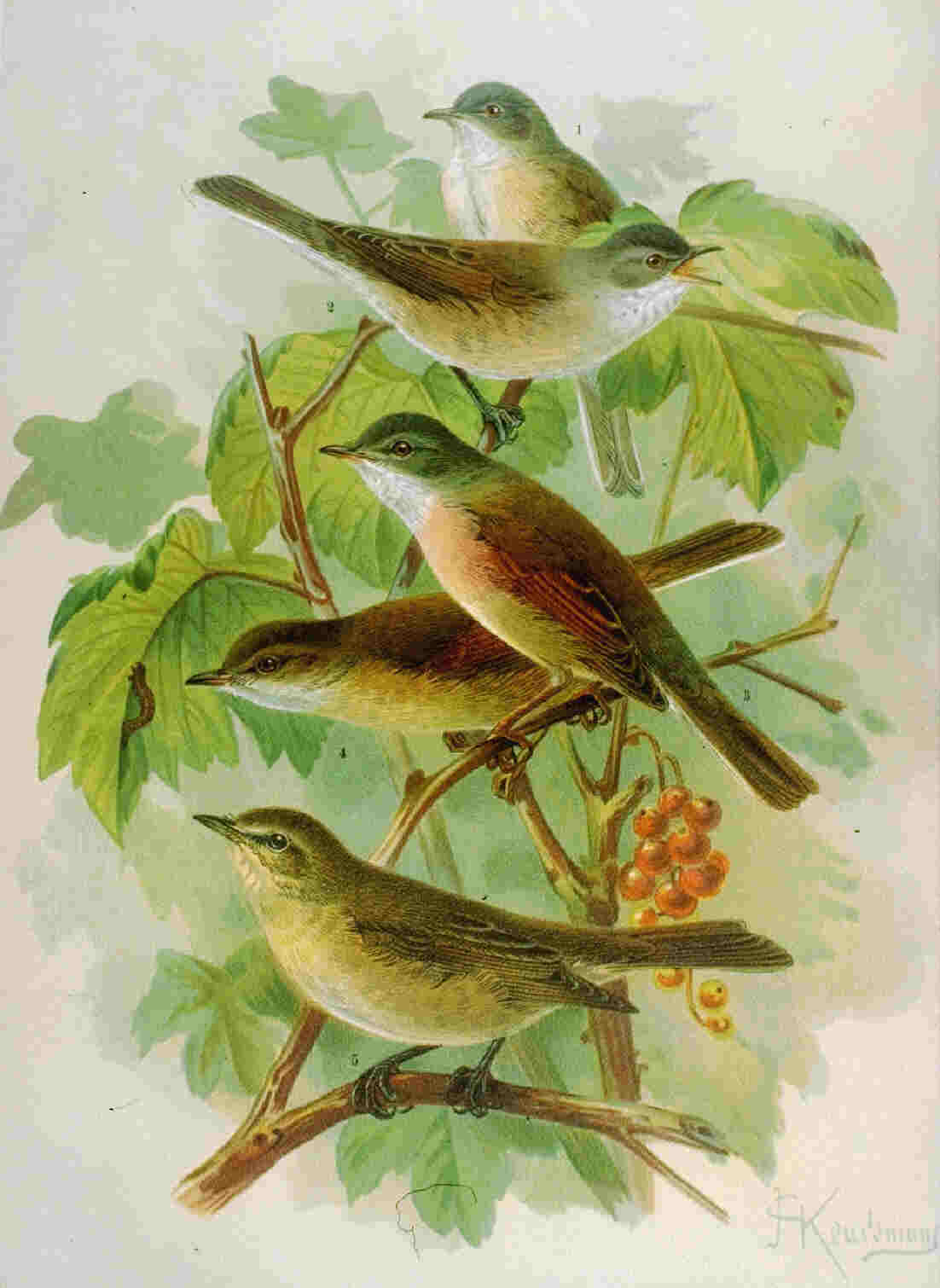- Typical warbler
Taxobox
name = Typical Warblers

image_width = 220px
image_caption = From top (males in front):Lesser Whitethroat ("Sylvia curruca")Whitethroat ("Sylvia communis")Garden Warbler ("Sylvia borin")
regnum =Animal ia
phylum =Chordata
classis =Aves
ordo =Passeriformes
familia =Sylviidae
genus = "Sylvia"
genus_authority = Scopoli,1769
genus2 = "Parisoma"
genus2_authority = Swainson in Richardson,1832
subdivision_ranks = Species
subdivision = About 25, see species listThe typical warblers are small insectivorous
bird s belonging to the genera "Sylvia" and "Parisoma" of the "Old World warbler" (more properly: sylviid warbler) familySylviidae . There are about 20 species in the genus "Sylvia", but their probable closest living relatives, "Parisoma " might actually belong herein too (Helbig 2001, Jønsson & Fjeldså 2006); the relationship to theAfrican Hillbabbler ("Pseudoalcippe abyssinica") and theWhite-browed Chinese Warbler ("Rhopophilus pekinensis") are not entirely resolved but certainly more distant. Typical warblers occur in thetemperate andsubtropical regions of westernEurasia and adjacentAfrica , centered around theMediterranean .Many of the "Sylvia" species show
sexual dimorphism , with distinctive male and femaleplumage s. A common feature is that males of some species have black on the heads, replaced by brown, gray or similar dusky colors in females. Species breeding in temperate regions are usually strongly migratory, although some are resident. These are active, constantly moving, warblers usually associated with fairly open woodland, hedges or shrubs.ystematics
The typical warblers are now known to form one major lineage in a
clade containing also theparrotbill s and sometaxa formerly considered trueOld World babbler s (Cibois 2003, Alström "et al." 2006). The other "Old World warblers" have been moved to their own families, entirely redelimiting the Sylviidae. Because of their distinctness, the "Sylvia"-"Parisoma" group might be considered asubfamily Sylviinae, but it must be noted that several "Old World warblers" are pending restudy with the new data in mind.As denoted above, the genus "Sylvia" as presently defined is not
monophyletic . The "Sylvia"-"Parisoma" group apparently contains one distinct major lineage and severalsuperspecies .Temperate Eurasian superspecies ("atricapilla-borin" group")
*Blackcap , "Sylvia atricapilla"
*Garden Warbler , "Sylvia borin""Parisoma" superspecies
*Banded Warbler , "Parisoma boehmi"
*Layard's Warbler , "Parisoma layardi"
*Rufous-vented Warbler , "Parisoma subcaeruleum""curruca" clade
*Brown Warbler , "Parisoma lugens"
*Yemen Warbler , "Sylvia buryi" - sometimes placed in "Parisoma"
*Red Sea Warbler , "Sylvia leucomelaena"
* (Western) Orphean Warbler, "Sylvia hortensis"
** Eastern Orphean Warbler, "Sylvia (hortensis) crassirostris"
*Lesser Whitethroat , "Sylvia curruca"
*Hume's Whitethroat , "Sylvia althaea"
*Small Whitethroat , "Sylvia minula"
** Margelanic Whitethroat, "Sylvia (minula) margelanica""communis"-"melanocephala" assemblage
*Barred Warbler , "Sylvia nisoria" - tentatively place here
*Asian Desert Warbler , "Sylvia nana"
*African Desert Warbler , "Sylvia deserti"
*Whitethroat , "Sylvia communis"
*Spectacled Warbler , "Sylvia conspicillata"
*Tristram's Warbler , "Sylvia deserticola"
*Dartford Warbler , "Sylvia undata"
*Marmora's Warbler , "Sylvia sarda"
** Balearic Warbler, "Sylvia (sarda) balearica"
*Rüppell's Warbler , "Sylvia rueppelli"
*Cyprus Warbler , "Sylvia melanothorax"
* (Western) Subalpine Warbler, "Sylvia cantillans"
** Eastern Subalpine Warbler, "Sylvia (cantillans) albistriata"
** Moltoni's Warbler, "Sylvia (cantillans) moltonii"
*Sardinian Warbler , "Sylvia melanocephala"
** "Sylvia (melanocephala) momus"
** Fayyum Warbler, "Sylvia melanocephala/momus norissae" - doubtfully distinct,extinct (c.1940 )
*Menetries' Warbler , "Sylvia mystacea"The relationships between the last group and the other species are not well resolved (Helbig 2001, Jønsson & Fjeldså 2006).
References
* Alström, Per; Ericson, Per G.P.; Olsson, Urban & Sundberg, Per (2006): Phylogeny and classification of the avian superfamily Sylvioidea. "Molecular Phylogenetics and Evolution" 38(2): 381–397. doi|10.1016/j.ympev.2005.05.015
* Cibois, Alice (2003): Mitochondrial DNA Phylogeny of Babblers (Timaliidae). "Auk" 120(1): 1-20. DOI: 10.1642/0004-8038(2003)120 [0035:MDPOBT] 2.0.CO;2 [http://findarticles.com/p/articles/mi_qa3793/is_200301/ai_n9225604 HTML fulltext without images]
* Del Hoyo, J.; Elliot, A. & Christie D. (editors). (2006). "
Handbook of the Birds of the World ". Volume 11: Old World Flycatchers to Old World Warblers. Lynx Edicions. ISBN 849655306X.* Helbig, A. J. (2001): The characteristics of the genus: Phylogeny and biogeography of the genus "Sylvia". "In:" Shirihai, Hadoram: "Sylvia warblers": 24–28. Princeton University Press, Princeton, N.J.. ISBN 0691088330
* Jønsson, Knud A. & Fjeldså, Jon (2006): A phylogenetic supertree of oscine passerine birds (Aves: Passeri). "Zool. Scripta" 35(2): 149–186. doi|:10.1111/j.1463-6409.2006.00221.x (HTML abstract)
External links
* [http://ibc.hbw.com/ibc/phtml/familia.phtml?idFamilia=139 Typical warbler videos] on the Internet Bird Collection
Wikimedia Foundation. 2010.
